turn signal JEEP COMPASS 2016 1.G Owner's Manual
[x] Cancel search | Manufacturer: JEEP, Model Year: 2016, Model line: COMPASS, Model: JEEP COMPASS 2016 1.GPages: 148, PDF Size: 8.42 MB
Page 82 of 148
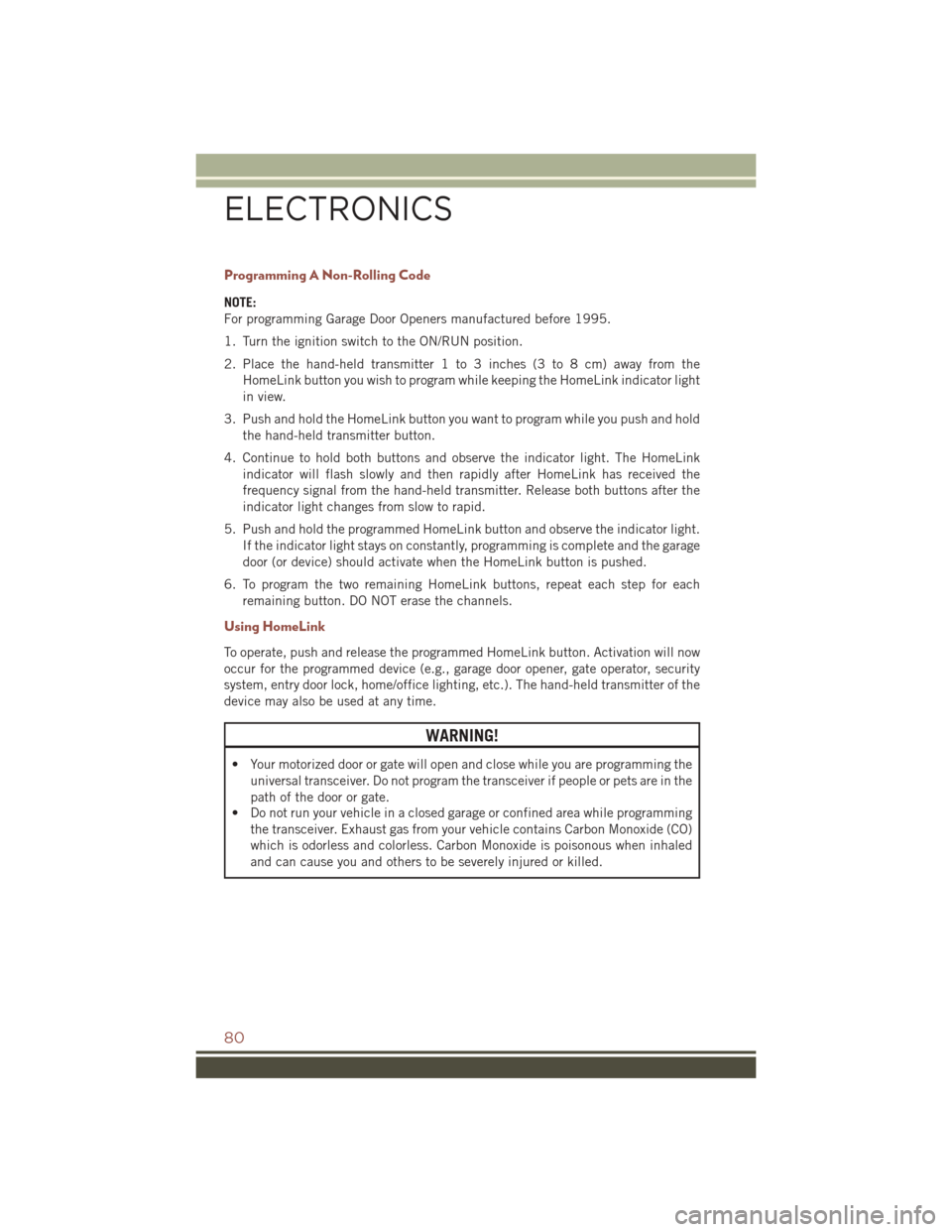
Programming A Non-Rolling Code
NOTE:
For programming Garage Door Openers manufactured before 1995.
1. Turn the ignition switch to the ON/RUN position.
2. Place the hand-held transmitter 1 to 3 inches (3 to 8 cm) away from theHomeLink button you wish to program while keeping the HomeLink indicator light
in view.
3. Push and hold the HomeLink button you want to program while you push and hold the hand-held transmitter button.
4. Continue to hold both buttons and observe the indicator light. The HomeLink indicator will flash slowly and then rapidly after HomeLink has received the
frequency signal from the hand-held transmitter. Release both buttons after the
indicator light changes from slow to rapid.
5. Push and hold the programmed HomeLink button and observe the indicator light. If the indicator light stays on constantly, programming is complete and the garage
door (or device) should activate when the HomeLink button is pushed.
6. To program the two remaining HomeLink buttons, repeat each step for each remaining button. DO NOT erase the channels.
Using HomeLink
To operate, push and release the programmed HomeLink button. Activation will now
occur for the programmed device (e.g., garage door opener, gate operator, security
system, entry door lock, home/office lighting, etc.). The hand-held transmitter of the
device may also be used at any time.
WARNING!
• Your motorized door or gate will open and close while you are programming theuniversal transceiver. Do not program the transceiver if people or pets are in the
path of the door or gate.
• Do not run your vehicle in a closed garage or confined area while programming
the transceiver. Exhaust gas from your vehicle contains Carbon Monoxide (CO)
which is odorless and colorless. Carbon Monoxide is poisonous when inhaled
and can cause you and others to be severely injured or killed.
ELECTRONICS
80
Page 90 of 148
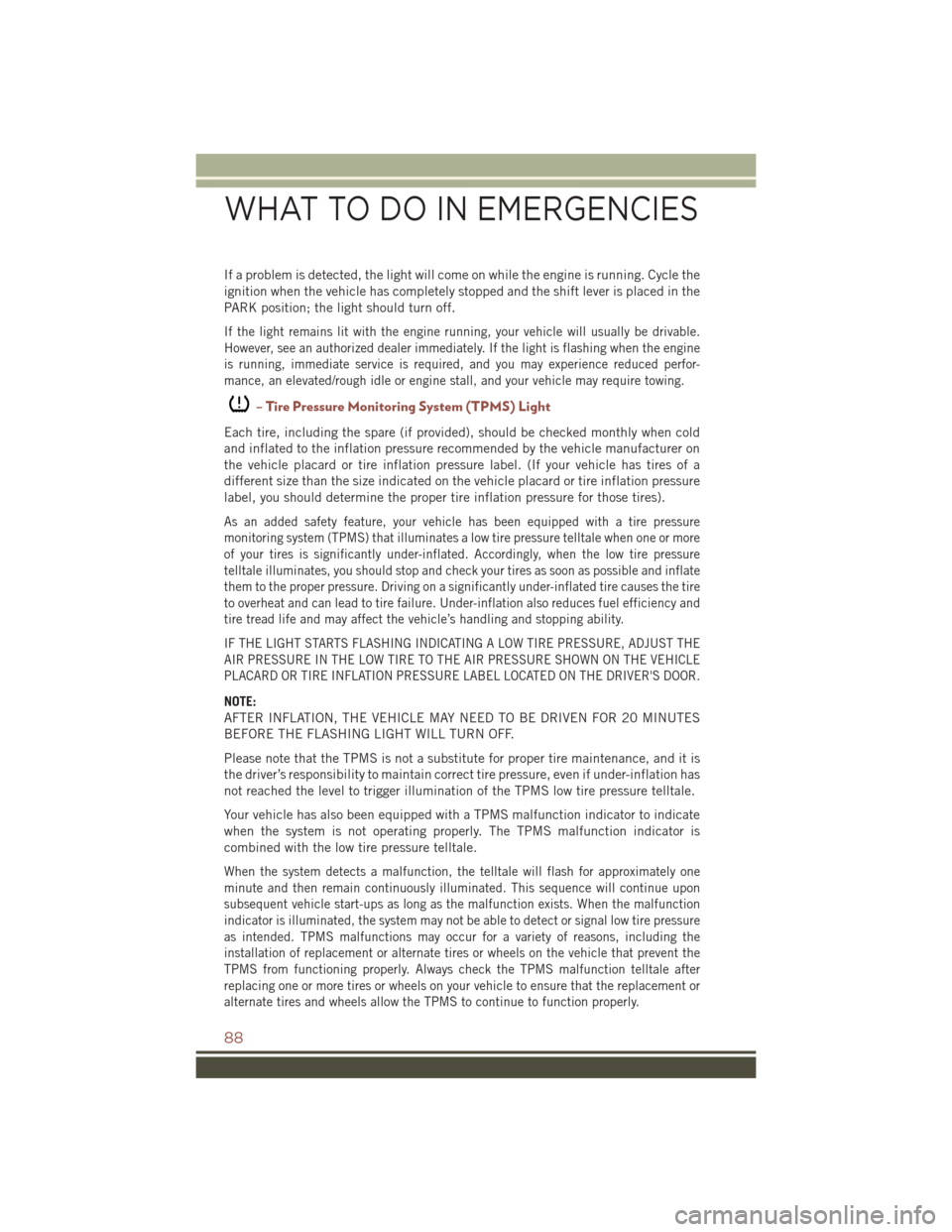
If a problem is detected, the light will come on while the engine is running. Cycle the
ignition when the vehicle has completely stopped and the shift lever is placed in the
PARK position; the light should turn off.
If the light remains lit with the engine running, your vehicle will usually be drivable.
However, see an authorized dealer immediately. If the light is flashing when the engine
is running, immediate service is required, and you may experience reduced perfor-
mance, an elevated/rough idle or engine stall, and your vehicle may require towing.
– Tire Pressure Monitoring System (TPMS) Light
Each tire, including the spare (if provided), should be checked monthly when cold
and inflated to the inflation pressure recommended by the vehicle manufacturer on
the vehicle placard or tire inflation pressure label. (If your vehicle has tires of a
different size than the size indicated on the vehicle placard or tire inflation pressure
label, you should determine the proper tire inflation pressure for those tires).
As an added safety feature, your vehicle has been equipped with a tire pressure
monitoring system (TPMS) that illuminates a low tire pressure telltale when one or more
of your tires is significantly under-inflated. Accordingly, when the low tire pressure
telltale illuminates, you should stop and check your tires as soon as possible and inflate
them to the proper pressure. Driving on a significantly under-inflated tire causes the tire
to overheat and can lead to tire failure. Under-inflation also reduces fuel efficiency and
tire tread life and may affect the vehicle’s handling and stopping ability.
IF THE LIGHT STARTS FLASHING INDICATING A LOW TIRE PRESSURE, ADJUST THE
AIR PRESSURE IN THE LOW TIRE TO THE AIR PRESSURE SHOWN ON THE VEHICLE
PLACARD OR TIRE INFLATION PRESSURE LABEL LOCATED ON THE DRIVER'S DOOR.
NOTE:
AFTER INFLATION, THE VEHICLE MAY NEED TO BE DRIVEN FOR 20 MINUTES
BEFORE THE FLASHING LIGHT WILL TURN OFF.
Please note that the TPMS is not a substitute for proper tire maintenance, and it is
the driver’s responsibility to maintain correct tire pressure, even if under-inflation has
not reached the level to trigger illumination of the TPMS low tire pressure telltale.
Your vehicle has also been equipped with a TPMS malfunction indicator to indicate
when the system is not operating properly. The TPMS malfunction indicator is
combined with the low tire pressure telltale.
When the system detects a malfunction, the telltale will flash for approximately one
minute and then remain continuously illuminated. This sequence will continue upon
subsequent vehicle start-ups as long as the malfunction exists. When the malfunction
indicator is illuminated, the system may not be able to detect or signal low tire pressure
as intended. TPMS malfunctions may occur for a variety of reasons, including the
installation of replacement or alternate tires or wheels on the vehicle that prevent the
TPMS from functioning properly. Always check the TPMS malfunction telltale after
replacing one or more tires or wheels on your vehicle to ensure that the replacement or
alternate tires and wheels allow the TPMS to continue to function properly.
WHAT TO DO IN EMERGENCIES
88
Page 93 of 148
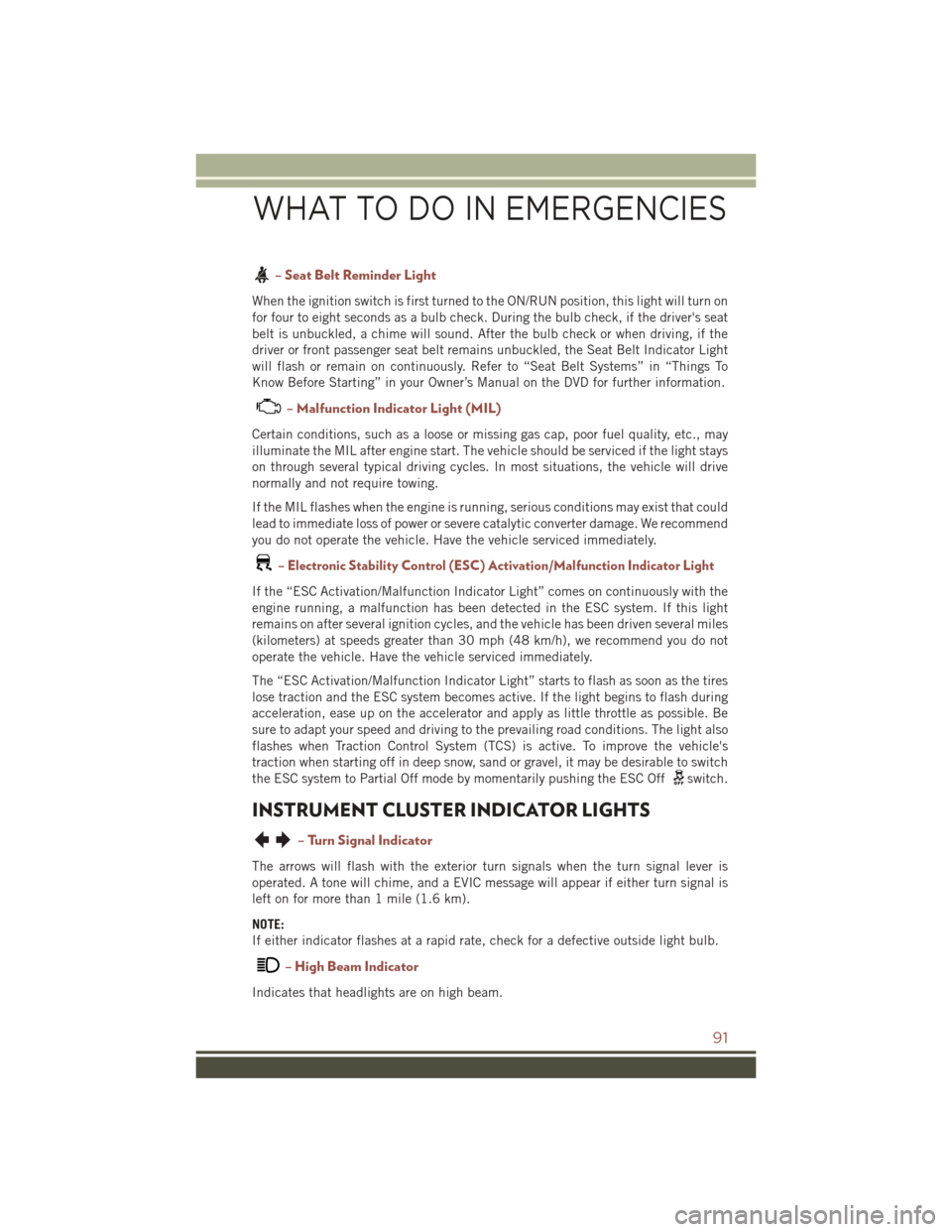
– Seat Belt Reminder Light
When the ignition switch is first turned to the ON/RUN position, this light will turn on
for four to eight seconds as a bulb check. During the bulb check, if the driver's seat
belt is unbuckled, a chime will sound. After the bulb check or when driving, if the
driver or front passenger seat belt remains unbuckled, the Seat Belt Indicator Light
will flash or remain on continuously. Refer to “Seat Belt Systems” in “Things To
Know Before Starting” in your Owner’s Manual on the DVD for further information.
– Malfunction Indicator Light (MIL)
Certain conditions, such as a loose or missing gas cap, poor fuel quality, etc., may
illuminate the MIL after engine start. The vehicle should be serviced if the light stays
on through several typical driving cycles. In most situations, the vehicle will drive
normally and not require towing.
If the MIL flashes when the engine is running, serious conditions may exist that could
lead to immediate loss of power or severe catalytic converter damage. We recommend
you do not operate the vehicle. Have the vehicle serviced immediately.
–Electronic Stability Control (ESC) Activation/Malfunction Indicator Light
If the “ESC Activation/Malfunction Indicator Light” comes on continuously with the
engine running, a malfunction has been detected in the ESC system. If this light
remains on after several ignition cycles, and the vehicle has been driven several miles
(kilometers) at speeds greater than 30 mph (48 km/h), we recommend you do not
operate the vehicle. Have the vehicle serviced immediately.
The “ESC Activation/Malfunction Indicator Light” starts to flash as soon as the tires
lose traction and the ESC system becomes active. If the light begins to flash during
acceleration, ease up on the accelerator and apply as little throttle as possible. Be
sure to adapt your speed and driving to the prevailing road conditions. The light also
flashes when Traction Control System (TCS) is active. To improve the vehicle's
traction when starting off in deep snow, sand or gravel, it may be desirable to switch
the ESC system to Partial Off mode by momentarily pushing the ESC Off
switch.
INSTRUMENT CLUSTER INDICATOR LIGHTS
– Turn Signal Indicator
The arrows will flash with the exterior turn signals when the turn signal lever is
operated. A tone will chime, and a EVIC message will appear if either turn signal is
left on for more than 1 mile (1.6 km).
NOTE:
If either indicator flashes at a rapid rate, check for a defective outside light bulb.
– High Beam Indicator
Indicates that headlights are on high beam.
WHAT TO DO IN EMERGENCIES
91
Page 128 of 148
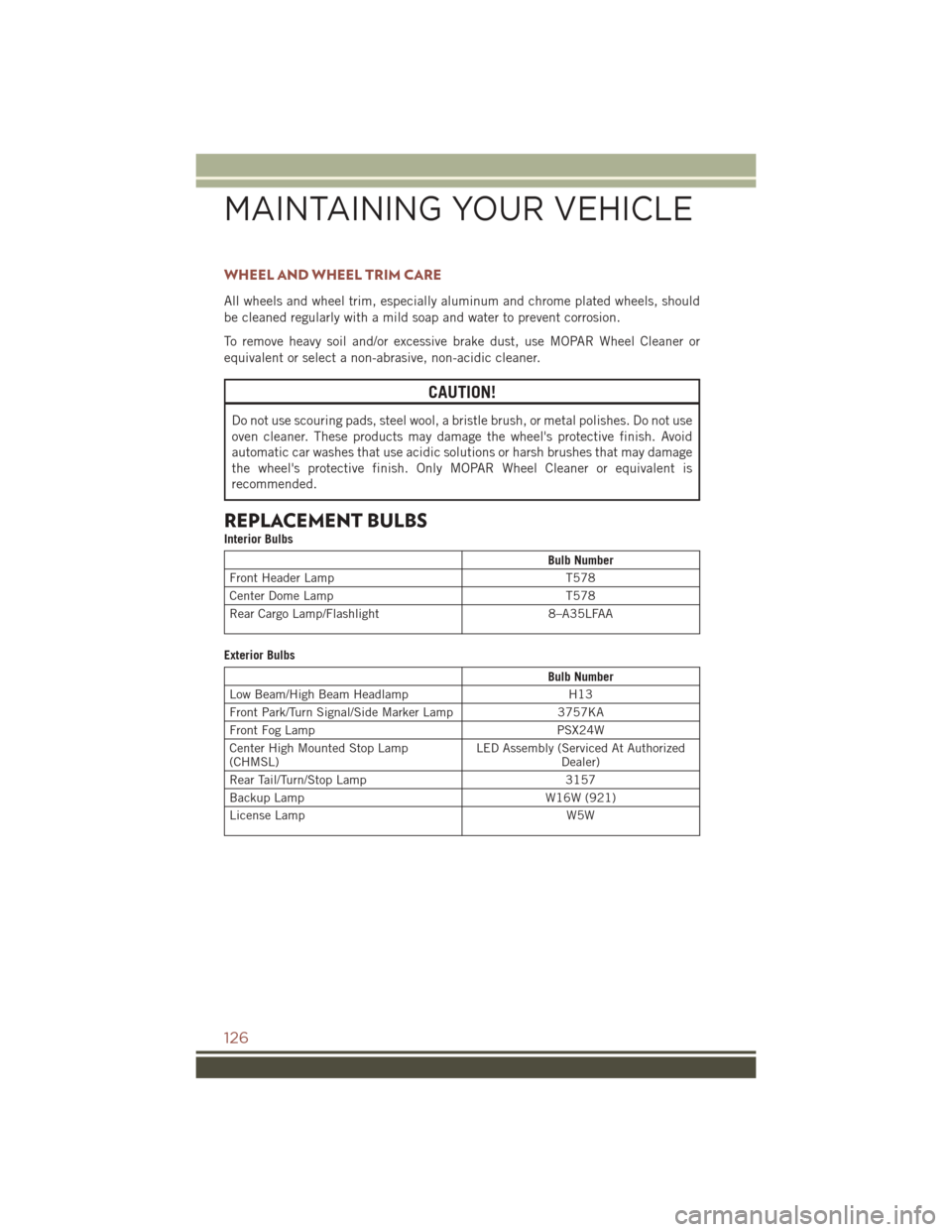
WHEEL AND WHEEL TRIM CARE
All wheels and wheel trim, especially aluminum and chrome plated wheels, should
be cleaned regularly with a mild soap and water to prevent corrosion.
To remove heavy soil and/or excessive brake dust, use MOPAR Wheel Cleaner or
equivalent or select a non-abrasive, non-acidic cleaner.
CAUTION!
Do not use scouring pads, steel wool, a bristle brush, or metal polishes. Do not use
oven cleaner. These products may damage the wheel's protective finish. Avoid
automatic car washes that use acidic solutions or harsh brushes that may damage
the wheel's protective finish. Only MOPAR Wheel Cleaner or equivalent is
recommended.
REPLACEMENT BULBS
Interior Bulbs
Bulb Number
Front Header Lamp T578
Center Dome Lamp T578
Rear Cargo Lamp/Flashlight 8–A35LFAA
Exterior Bulbs
Bulb Number
Low Beam/High Beam Headlamp H13
Front Park/Turn Signal/Side Marker Lamp 3757KA
Front Fog Lamp PSX24W
Center High Mounted Stop Lamp
(CHMSL) LED Assembly (Serviced At Authorized
Dealer)
Rear Tail/Turn/Stop Lamp 3157
Backup Lamp W16W (921)
License Lamp W5W
MAINTAINING YOUR VEHICLE
126
Page 135 of 148
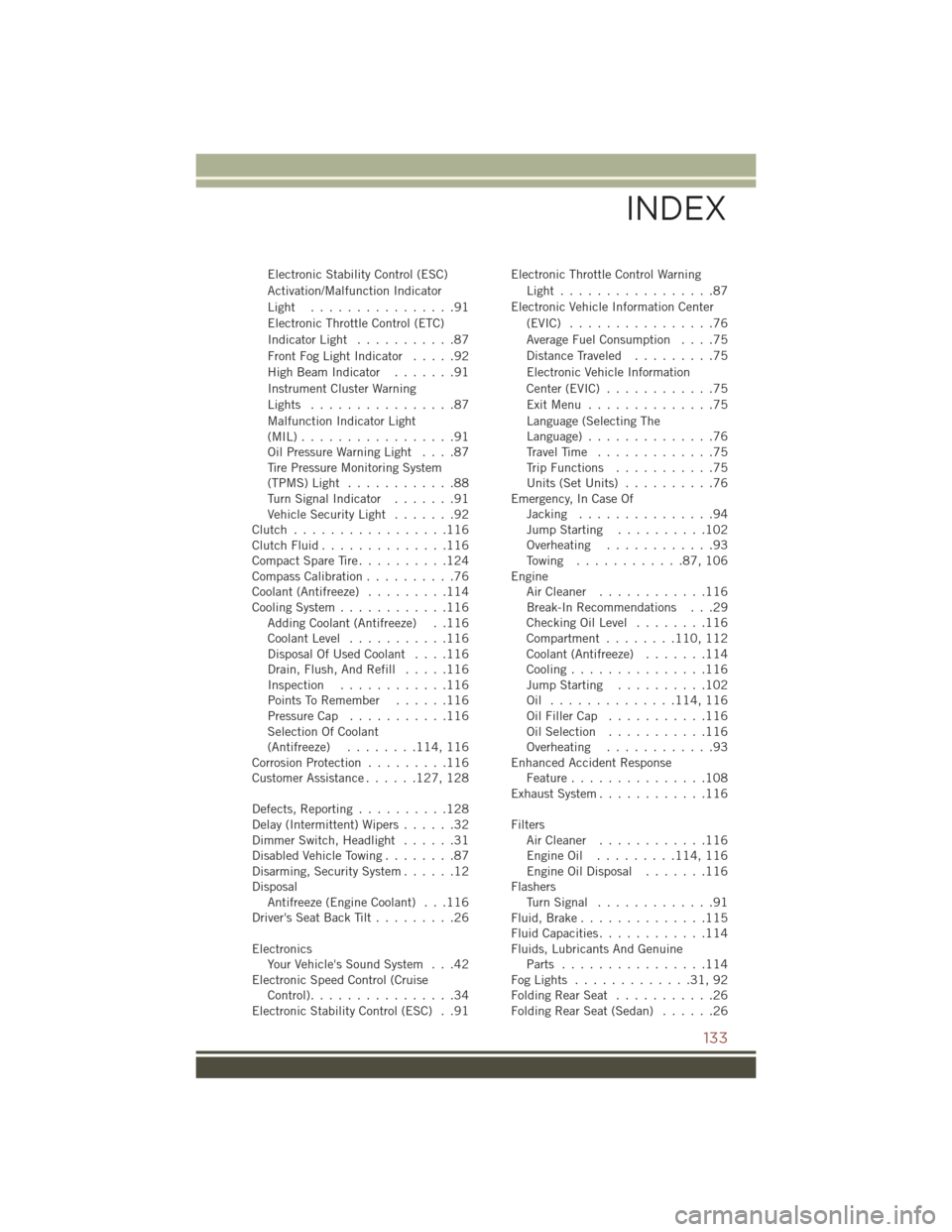
Electronic Stability Control (ESC)
Activation/Malfunction Indicator
Light ................91
Electronic Throttle Control (ETC)
Indicator Light...........87
FrontFogLightIndicator .....92
HighBeamIndicator .......91
Instrument Cluster Warning
Lights ................87
Malfunction Indicator Light
(MIL).................91
Oil Pressure Warning Light ....87
Tire Pressure Monitoring System
(TPMS) Light ............88
Turn Signal Indicator .......91
Vehicle Security Light .......92
Clutch .................116
ClutchFluid..............116
Compact Spare Tire ..........124
Compass Calibration ..........76
Coolant (Antifreeze) .........114
Cooling System ............116
Adding Coolant (Antifreeze) . .116
Coolant Level ...........116
Disposal Of Used Coolant ....116
Drain, Flush, And Refill .....116
Inspection ............116
Points To Remember ......116
Pressure Cap ...........116
Selection Of Coolant
(Antifreeze) ........114, 116
Corrosion Protection .........116
Customer Assistance ......127, 128
Defects, Reporting ..........128
Delay (Intermittent) Wipers ......32
Dimmer Switch, Headlight ......31
Disabled Vehicle Towing ........87
Disarming, Security System ......12
Disposal Antifreeze (Engine Coolant) . . .116
Driver's Seat Back Tilt .........26
Electronics Your Vehicle's Sound System . . .42
Electronic Speed Control (Cruise Control) ................34
Electronic Stability Control (ESC) . .91 Electronic Throttle Control Warning
Light.................87
Electronic Vehicle Information Center (EVIC) ................76
Average Fuel Consumption ....75
Distance Traveled .........75
Electronic Vehicle Information
Center (EVIC) ............75
ExitMenu ..............75
Language (Selecting The
Language) ..............76
Travel Time .............75
Trip Functions ...........75
Units (Set Units) ..........76
Emergency, In Case Of Jacking ...............94
Jump Starting ..........102
Overheating ............93
Towing ............87,106
Engine Air Cleaner ............116
Break-In Recommendations . . .29
Checking Oil Level ........116
Compartment ........110, 112
Coolant (Antifreeze) .......114
Cooling ...............116
Jump Starting ..........102
Oil .............. 114, 116
Oil
Filler Cap ...........116
Oil Selection ...........116
Overheating ............93
Enhanced Accident Response Feature ...............108
Exhaust System ............116
Filters Air Cleaner ............116
EngineOil ......... 114, 116
Engine Oil Disposal .......116
Flashers TurnSignal .............91
Fluid, Brake ..............115
Fluid Capacities ............114
Fluids, Lubricants And Genuine Parts ................114
FogLights .............31,92
FoldingRearSeat ...........26
FoldingRearSeat(Sedan) ......26
INDEX
133
Page 137 of 148
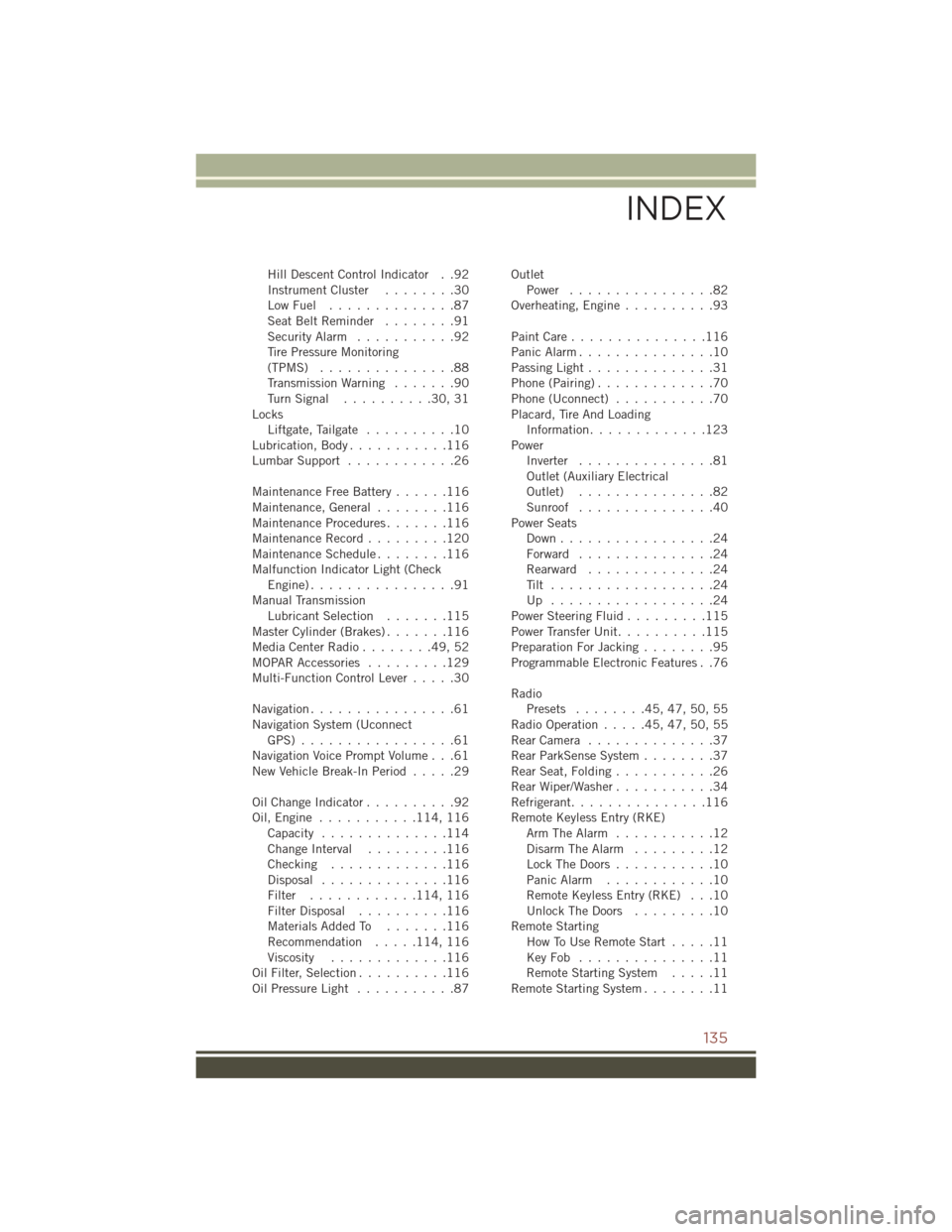
Hill Descent Control Indicator . .92
InstrumentCluster ........30
LowFuel ..............87
SeatBeltReminder ........91
Security Alarm...........92
Tire Pressure Monitoring
(TPMS) ...............88
Transmission Warning .......90
TurnSignal ..........30,31
Locks Liftgate, Tailgate ..........10
Lubrication, Body ...........116
Lumbar Support ............26
Maintenance Free Battery ......116
Maintenance,General ........116
MaintenanceProcedures.......116
Maintenance Record .........120
MaintenanceSchedule........116
Malfunction Indicator Light (Check Engine)................91
Manual Transmission Lubricant Selection .......115
Master Cylinder (Brakes) .......116
MediaCenterRadio........49,52
MOPAR Accessories .........129
Multi-Function Control Lever .....30
Navigation ................61
Navigation System (Uconnect GPS) .................61
Navigation Voice Prompt Volume . . .61
New Vehicle Break-In Period .....29
OilChangeIndicator..........92
Oil,Engine ........... 114, 116
Capacity ..............114
Change Interval .........116
Checking .............116
Disposal ..............116
Filter ............ 114, 116
Filter Disposal ..........116
Materials Added To .......116
Recommendation .....114, 116
Viscosity .............116
Oil Filter, Selection ..........116
Oil Pressure Light ...........87 Outlet
Power ................82
Overheating, Engine ..........93
PaintCare...............116
Panic Alarm ...............10
Passing Light ..............31
Phone (Pairing) .............70
Phone (Uconnect) ...........70
Placard, Tire And Loading Information .............123
Power Inverter ...............81
Outlet (Auxiliary Electrical
Outlet) ...............82
Sunroof ...............40
Power Seats Down.................24
Forward ...............24
Rearward ..............24
Tilt ..................24
Up ..................24
Power Steering Fluid .........115
Power Transfer Unit ..........115
Preparation For Jacking ........95
Programmable Electronic Features . .76
Radio Presets ........45,47,50,55
RadioOperation.....45,47,50,55
R
earCamera ..............37
Rear ParkSense System ........37
Rear Seat, Folding ...........26
Rear Wiper/Washer ...........34
Refrigerant ...............116
Remote Keyless Entry (RKE) Arm The Alarm ...........12
Disarm The Alarm .........12
Lock The Doors ...........10
Panic Alarm ............10
Remote Keyless Entry (RKE) . . .10
Unlock The Doors .........10
Remote Starting How To Use Remote Start .....11
KeyFob ...............11
Remote Starting System .....11
Remote Starting System ........11
INDEX
135
Page 138 of 148
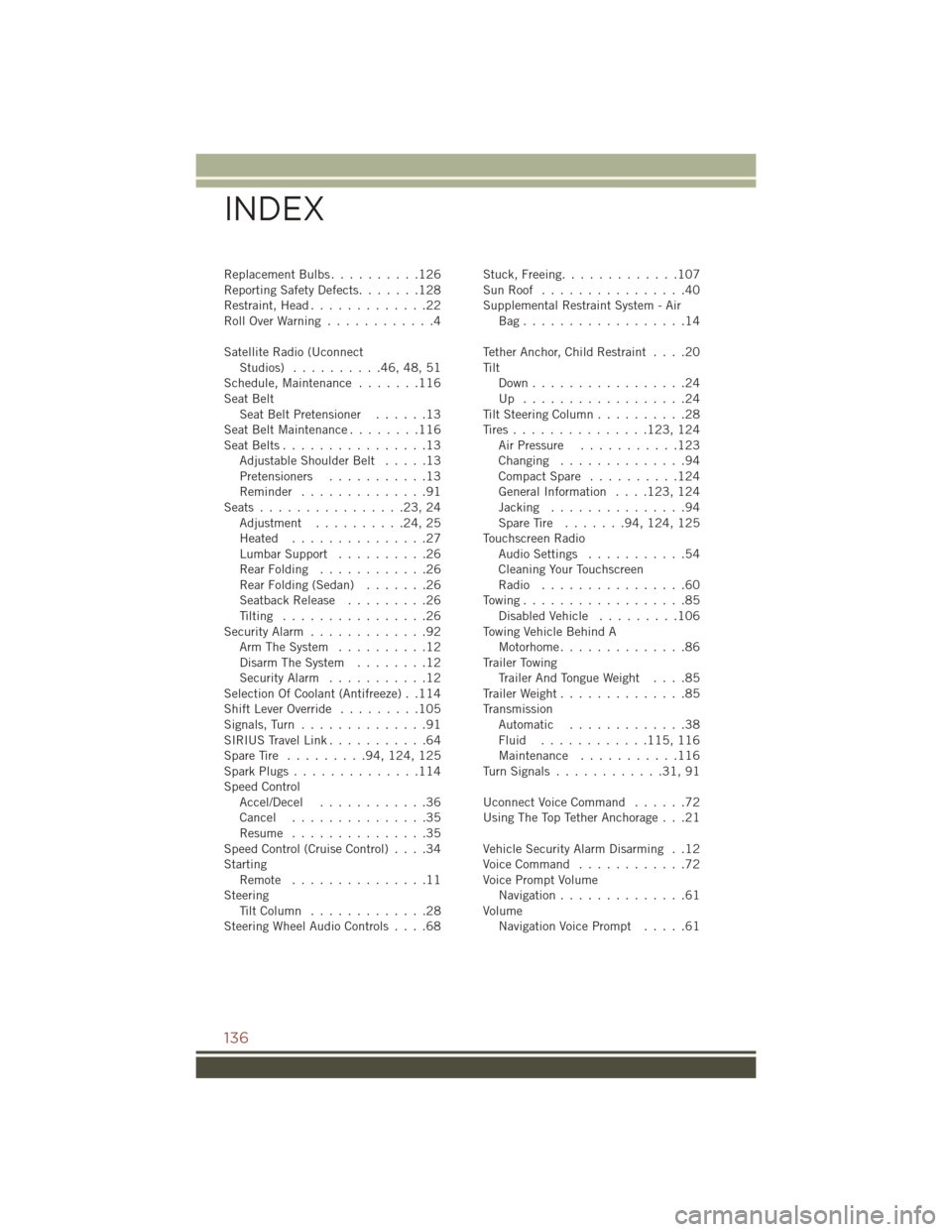
ReplacementBulbs..........126
Reporting Safety Defects.......128
Restraint, Head .............22
RollOverWarning ............4
Satellite Radio (Uconnect Studios) ..........46,48,51
Schedule, Maintenance .......116
Seat Belt Seat Belt Pretensioner ......13
SeatBeltMaintenance........116
Seat Belts ................13
AdjustableShoulderBelt .....13
Pretensioners ...........13
Reminder ..............91
Seats................23,24 Adjustment ..........24,25
Heated ...............27
Lumbar Support ..........26
RearFolding ............26
RearFolding(Sedan) .......26
Seatback Release .........26
Tilting ................26
Security Alarm .............92
Arm The System ..........12
Disarm The System ........12
Security Alarm ...........12
Selection Of Coolant (Antifreeze) . .114
Shift Lever Override .........105
Signals, Turn ..............91
SIRIUSTravelLink...........64
Spare Tire .........94, 124, 125
Spark Plugs ..............114
Speed Control Accel/Decel ............36
Cancel ...............35
Resume ...............35
Speed Control (Cruise Control) ....34
Starting Remote ...............11
Steering TiltColumn .............28
Steering Wheel Audio Controls ....68Stuck, Freeing
.............107
SunRoof ................40
Supplemental Restraint System - Air Bag..................14
Tether Anchor, Child Restraint ....20
Tilt Down .................24
Up ..................24
Tilt Steering Column ..........28
Tires ............... 123, 124
Air Pressure ...........123
Changing ..............94
Compact Spare ..........124
General Information ....123, 124
Jacking ...............94
SpareTire .......94, 124, 125
Touchscreen Radio Audio Settings ...........54
Cleaning Your Touchscreen
Radio ................60
Towing..................85 Disabled Vehicle .........106
Towing Vehicle Behind A Motorhome ..............86
Trailer Towing Trailer And Tongue Weight ....85
T
railer Weight ..............85
Transmission Automatic .............38
Fluid ............ 115, 116
Maintenance ...........116
TurnSignals............31,91
Uconnect Voice Command ......72
Using The Top Tether Anchorage . . .21
Vehicle Security Alarm Disarming . .12
Voice Command ............72
Voice Prompt Volume Navigation ..............61
Volume Navigation Voice Prompt .....61
INDEX
136